Modulating the Spin Seebeck Effect in Co2FeAl Heusler Alloy for Sensor Applications
Abstract
1. Introduction
2. Materials and Methods
3. Results and Discussion
3.1. Structural Results
3.2. Magnetic Properties
3.3. Modeling a System with Uniaxial Magnetic Anisotropy Combined with Cubic Magnetic Anisotropy
3.4. Magnetic Response at Saturated State
3.5. Experimental Results for Thermoelectric Effect
3.6. Theoretical Approach for Thermoelectric Effect
3.7. Numerical Calculations and Comparison between Theory and Experiment
4. Conclusions
Author Contributions
Funding
Acknowledgments
Conflicts of Interest
References
- Raijmakers, L.; Danilov, D.; Eichel, R.A.; Notten, P. A review on various temperature-indication methods for Li-ion batteries. Appl. Energy 2019, 240, 918–945. [Google Scholar] [CrossRef]
- Van Herwaarden, A.; Sarro, P. Thermal sensors based on the seebeck effect. Sens. Actuators 1986, 10, 321–346. [Google Scholar] [CrossRef]
- Bali, A.; Chetty, R.; Mallik, R.C. Thin Film Thermoelectric Materials for Sensor Applications: An Overview. In Thin Film Structures in Energy Applications; Springer International Publishing: Cham, Switzerland, 2015. [Google Scholar]
- Kirihara, A.; Kondo, K.; Ishida, M.; Ihara, K.; Iwasaki, Y.; Someya, H.; Matsuba, A.; Uchida, K.I.; Saitoh, E.; Yamamoto, N.; et al. Flexible heat-flow sensing sheets based on the longitudinal spin Seebeck effect using one-dimensional spin-current conducting films. Sci. Rep. 2016, 6, 23114. [Google Scholar] [CrossRef] [PubMed]
- Uchida, K.; Ishida, M.; Kikkawa, T.; Kirihara, A.; Murakami, T.; Saitoh, E. Longitudinal spin Seebeck effect: From fundamentals to applications. J. Phys. Condens. Matter 2014, 26, 343202. [Google Scholar] [CrossRef] [PubMed]
- Duan, Z.; Miao, B.; Sun, L.; Wu, D.; Du, J.; Ding, H. The Longitudinal Spin Seebeck Coefficient of Fe. IEEE Magn. Lett. 2019, 10, 1–5. [Google Scholar] [CrossRef]
- Hou, D.; Qiu, Z.; Saitoh, E. Spin transport in antiferromagnetic insulators: Progress and challenges. NPG Asia Mater. 2019, 11, 35. [Google Scholar] [CrossRef]
- Sengupta, P.; Wen, Y.; Shi, J. Spin-dependent magneto-thermopower of narrow-gap lead chalcogenide quantum wells. Sci. Rep. 2018, 8, 5972. [Google Scholar] [CrossRef]
- Mani, A.; Pal, S.; Benjamin, C. Designing a highly efficient graphene quantum spin heat engine. Sci. Rep. 2019, 9, 6018. [Google Scholar] [CrossRef]
- Ando, K.; Morikawa, M.; Trypiniotis, T.; Fujikawa, Y.; Barnes, C.H.W.; Saitoh, E. Direct conversion of light-polarization information into electric voltage using photoinduced inverse spin-Hall effect in Pt/GaAs hybrid structure: Spin photodetector. J. Appl. Phys. 2010, 107, 113902. [Google Scholar] [CrossRef]
- Isella, G.; Bottegoni, F.; Ferrari, A.; Finazzi, M.; Ciccacci, F. Photon energy dependence of photo-induced inverse spin-Hall effect in Pt/GaAs and Pt/Ge. Appl. Phys. Lett. 2015, 106, 232402. [Google Scholar] [CrossRef]
- Zhang, Z.Q.; Yang, Y.R.; Fu, H.H.; Wu, R. Design of spin-Seebeck diode with spin semiconductors. Nanotechnology 2016, 27, 505201. [Google Scholar] [CrossRef] [PubMed]
- Liao, T.; Ye, Z.; Chen, J. Spin-Seebeck Temperature Sensors. IEEE Trans. Electron Devices 2017, 64, 2655–2658. [Google Scholar] [CrossRef]
- Bauer, G.E.W.; Saitoh, E.; van Wees, B.J. Spin caloritronics. Nat. Mater. 2012, 11, 391–399. [Google Scholar] [CrossRef] [PubMed]
- Sakuraba, Y.; Hasegawa, K.; Mizuguchi, M.; Kubota, T.; Mizukami, S.; Miyazaki, T.; Takanashi, K. Anomalous Nernst Effect in L10-FePt/MnGa Thermopiles for New Thermoelectric Applications. Appl. Phys. Express 2013, 6, 033003. [Google Scholar] [CrossRef]
- Zhang, B.; Meng, K.K.; Yang, M.Y.; Edmonds, K.; Zhang, H.; Cai, K.M.; Sheng, Y.; Zhang, N.; Ji, Y.; Zhao, J.H.; et al. Piezo voltage controlled planar Hall effect devices. Sci. Rep. 2016, 6, 28458. [Google Scholar] [CrossRef]
- Baxter, J.; Lesina, A.C.; Guay, J.M.; Weck, A.; Berini, P.; Ramunno, L. Plasmonic colours predicted by deep learning. Sci. Rep. 2019, 9, 8074. [Google Scholar] [CrossRef]
- Gueye, M.; Zighem, F.; Belmeguenai, M.; Gabor, M.; Tiusan, C.; Faurie, D. Effective 90-degree magnetization rotation in Co2FeAl thin film/piezoelectric system probed by microstripline ferromagnetic resonance. Appl. Phys. Lett. 2015, 107, 032908. [Google Scholar] [CrossRef]
- Kikkawa, T.; Uchida, K.; Daimon, S.; Shiomi, Y.; Adachi, H.; Qiu, Z.; Hou, D.; Jin, X.F.; Maekawa, S.; Saitoh, E. Separation of longitudinal spin Seebeck effect from anomalous Nernst effect: Determination of origin of transverse thermoelectric voltage in metal/insulator junctions. Phys. Rev. B 2013, 88, 214403. [Google Scholar] [CrossRef]
- Holanda, J.; Alves Santos, O.; Cunha, R.O.; Mendes, J.B.; Rodríguez-Suárez, R.L.; Azevedo, A.; Rezende, S.M. Longitudinal spin Seebeck effect in permalloy separated from the anomalous Nernst effect: Theory and experiment. Phys. Rev. B 2017, 95, 214421. [Google Scholar] [CrossRef]
- Manipatruni, S.; Nikonov, D.E.; Lin, C.C.; Gosavi, T.A.; Liu, H.; Prasad, B.; Huang, Y.L.; Bonturim, E.; Ramesh, R.; Young, I.A. Scalable energy-efficient magnetoelectric spin–orbit logic. Nature 2019, 565, 35. [Google Scholar] [CrossRef]
- Trudel, S.; Gaier, O.; Hamrle, J.; Hillebrands, B. Magnetic anisotropy, exchange and damping in cobalt-based full-Heusler compounds: An experimental review. J. Phys. D Appl. Phys. 2010, 43, 193001. [Google Scholar] [CrossRef]
- Husain, S.; Kumar, A.; Kumar, P.; Kumar, A.; Barwal, V.; Behera, N.; Choudhary, S.; Svedlindh, P.; Chaudhary, S. Spin pumping in the Heusler alloy Co2FeAl/MoS2 heterostructure: Ferromagnetic resonance experiment and theory. Phys. Rev. B 2018, 98, 180404. [Google Scholar] [CrossRef]
- Akansel, S.; Kumar, A.; Behera, N.; Husain, S.; Brucas, R.; Chaudhary, S.; Svedlindh, P. Thickness-dependent enhancement of damping in Co2FeAl/β-Ta thin films. Phys. Rev. B 2018, 97, 134421. [Google Scholar] [CrossRef]
- Boehnke, A.; Martens, U.; Sterwerf, C.; Niesen, A.; Huebner, T.; von der Ehe, M.; Meinert, M.; Kuschel, T.; Thomas, A.; Heiliger, C.; et al. Large magneto-Seebeck effect in magnetic tunnel junctions with half-metallic Heusler electrodes. Nat. Commun. 2017, 8, 1626. [Google Scholar] [CrossRef] [PubMed]
- Hu, S.; Itoh, H.; Kimura, T. Efficient thermal spin injection using CoFeAl nanowire. NPG Asia Mater. 2014, 6, e127-1–e127-5. [Google Scholar] [CrossRef]
- Inomata, K.; Ikeda, N.; Tezuka, N.; Goto, R.; Sugimoto, S.; Wojcik, M.; Jedryka, E. Highly spin-polarized materials and devices for spintronics. Sci. Tecnhol. Adv. Mater. 2008, 9, 014101. [Google Scholar] [CrossRef]
- Gabor, M.S.; Petrisor, T., Jr.; Tiusan, C.; Hehn, M.; Petrisor, T. Magnetic and structural anisotropies of Co2FeAl Heusler alloy epitaxial thin films. Phys. Rev. B 2011, 84, 134413. [Google Scholar] [CrossRef]
- Lai, B.; Zhang, X.; Lu, X.; Yang, L.; Wang, J.; Chen, Y.; Zhao, Y.; Li, Y.; Ruan, X.; Wang, X.; et al. Magnetic anisotropy of half-metallic Co2FeAl ultra-thin films epitaxially grown on GaAs (001). AIP Adv. 2019, 9, 065002. [Google Scholar] [CrossRef]
- Qiao, S.; Nie, S.; Zhao, J.; Zhang, X. Temperature dependent magnetic anisotropy of epitaxial Co2FeAl films grown on GaAs. J. Appl. Phys. 2015, 117, 093904. [Google Scholar] [CrossRef]
- Xu, X.; Zhang, D.; Wang, W.; Wu, Y.; Wang, Y.; Jiang, Y. Surface effects on the magnetic properties of Co2FeAl(001): An ab initio study. J. Magn. Magn. Mater. 2010, 322, 3351–3354. [Google Scholar] [CrossRef]
- Yu, L.; Gao, G.; Zhu, L.; Deng, L.; Yang, Z.; Yao, K. First principles study of magnetoelectric coupling in Co2FeAl/BaTiO3 tunnel junctions. Phys. Chem. Chem. Phys. 2015, 17, 14986–14993. [Google Scholar] [CrossRef] [PubMed]
- Li, J.; Zhang, G.; Peng, C.; Wang, W.; Yang, J.; Wang, Y.; Cheng, Z. Magneto-Seebeck effect in Co2FeAl/MgO/Co2FeAl: first-principles calculations. Phys. Chem. Chem. Phys. 2019, 21, 5803–5812. [Google Scholar] [CrossRef] [PubMed]
- Xu, X.; Zhang, D.; Wu, Y.; Zhang, X.; Li, X.; Yang, H.; Jiang, Y. Electronic structures of Heusler alloy Co2FeAl1-xSix surface. Rare Met. 2012, 31, 107–111. [Google Scholar] [CrossRef]
- Belmeguenai, M.; Tuzcuoglu, H.; Gabor, M.S.; Petrisor, T.; Tiusan, C.; Zighem, F.; Chérif, S.M.; Moch, P. Co2FeAl Heusler thin films grown on Si and MgO substrates: Annealing temperature effect. J. Appl. Phys. 2014, 115, 043918. [Google Scholar] [CrossRef]
- Gueye, M.; Wague, B.M.; Zighem, F.; Belmeguenai, M.; Gabor, M.S.; Petrisor, T., Jr.; Tiusan, C.; Mercone, S.; Faurie, D. Bending strain-tunable magnetic anisotropy in Co2FeAl Heusler thin film on Kapton®. Appl. Phys. Lett. 2014, 105, 062409-1–062409-4. [Google Scholar] [CrossRef]
- Belmeguenai, B.; Tuzcuoglu, H.; Gabor, M.S.; Petrisor, T., Jr.; Tiusan, C.; Berling, D.; Zighem, F.; Chauveau, T.; Chérif, S.M.; Moch, P. Co2FeAl thin films grown on MgO substrates: Correlation between static, dynamics, and structural properties. Phys. Rev. B 2013, 87, 184431. [Google Scholar] [CrossRef]
- Silva, A.; Escobar, V.; Callegari, G.; Agra, K.; Chesman, C.; Bohn, F.; Corrêa, M. Giant magnetoimpedance effect in Co2FeAl single layered and Co2FeAl/Ag multilayered films in amorphous substrates. Mat. Lett. 2015, 156, 90–93. [Google Scholar] [CrossRef]
- Melo, A.S.; de Oliveira, A.B.; Chesman, C.; Della Pace, R.D.; Bohn, F.; Correa, M.A. Anomalous nernst effect in stressed magnetostrictive film grown onto flexible substrate. Sci. Rep. 2019, 9, 15338. [Google Scholar] [CrossRef]
- Silva, E.F.; Correa, M.A.; Della Pace, R.D.; Plá Cid, C.C.; Kern, P.R.; Carara, M.; Chesman, C.; Alves Santos, O.; Rodríguez-Suárez, R.L.; Azevedo, A.; et al. Thickness dependence of the magnetic anisotropy and dynamic magnetic response of ferromagnetic NiFe films. J. Phys. D Appl. Phys. 2017, 50, 185001. [Google Scholar] [CrossRef]
- Janik, E.; Dłużewski, P.; Kret, S.; Presz, A.; Kirmse, H.; Neumann, W.; Zaleszczyk, W.; Baczewski, L.T.; Petroutchik, A.; Dynowska, E.; et al. Catalytic growth of ZnTe nanowires by molecular beam epitaxy: Structural studies. Nanotechnology 2007, 18, 475606. [Google Scholar] [CrossRef]
- Cao, X.A.; Hu, H.T.; Dong, Y.; Ding, X.M.; Hou, X.Y. The structural, chemical, and electronic properties of a stable GaS/GaAs interface. J. Appl. Phys. 1999, 86, 6940–6944. [Google Scholar] [CrossRef]
- Leo, G. Influence of a ZnTe buffer layer on the structural quality of CdTe epilayers grown on (100) GaAs by metalorganic vapor phase epitaxy. J. Vac. Sci. Technol. B Microelectron. Nanom. Struct. 1996, 14, 1739. [Google Scholar] [CrossRef]
- De Teresa, J.M.; Serrate, D.; Cordoba, R.; Yusuf, S.M. Correlation between the synthesis conditions and the compositional and magnetic properties of Co2(Cr1-xFex)Al Heusler alloys. J. Alloy. Compd. 2008, 450, 31–38. [Google Scholar] [CrossRef]
- Belmeguenai, M.; Gabor, M.S.; Zighem, F.; Roussigné, Y.; Faurie, D.; Tiusan, C. Annealing temperature and thickness dependencies of structural and magnetic properties of Co2FeAl thin films. Phys. Rev. B 2016, 94, 104424. [Google Scholar] [CrossRef]
- Bezerra, C.; Chesman, C.; Albuquerque, E.; Azevedo, A. Effects of the magneto-crystalline anisotropy on the magnetic properties of Fe/Cr/Fe (110) trilayer. Eur. Phys. J. B 2004, 39, 527–533. [Google Scholar] [CrossRef]
- Stoner, E.; Wohlfarth, E. A mechanism of magnetic hysteresis in heterogeneous alloys. Phil. Trans. Roy.Soc. 1948, 240, 599–642. [Google Scholar] [CrossRef]
- Tao, X.; Wang, H.; Miao, B.; Sun, L.; You, B.; Wu, D.; Zhang, W.; Oepen, H.; Zhao, J.; Ding, H. Unveiling the Mechanism for the Split Hysteresis Loop in Epitaxial Co2Fe1-xMnxAl Full-Heusler Alloy Films. Sci. Rep. 2016, 6, 18615. [Google Scholar] [CrossRef]
- Pandey, H.; Joshi, P.; Pant, R.P.; Prasad, R.; Auluck, S.; Budhani, R. Evolution of ferromagnetic and spin-wave resonances with crystalline order in thin films of full-Heusler alloy Co2MnSi. J. Appl. Phys. 2012, 111, 023912. [Google Scholar] [CrossRef]

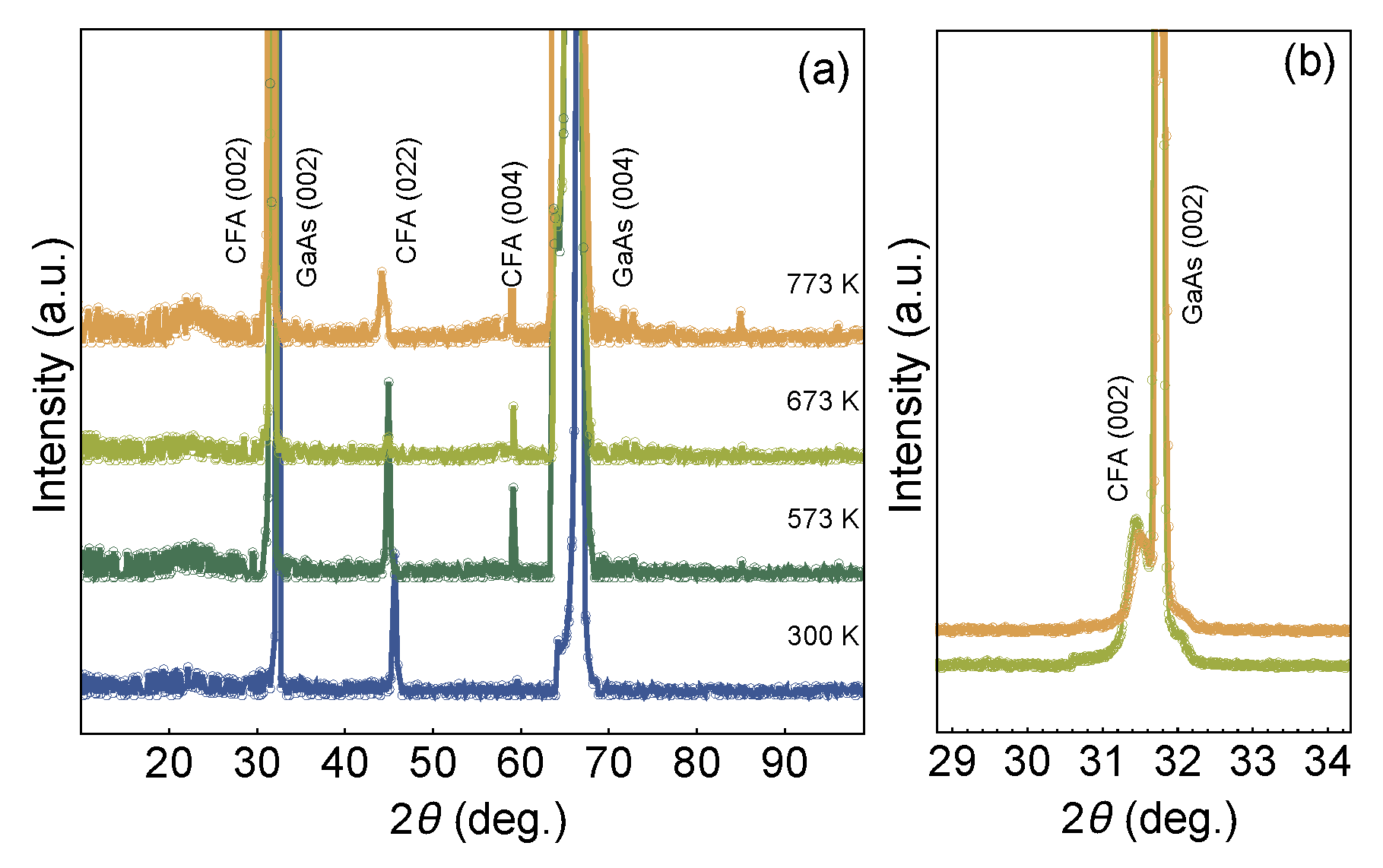
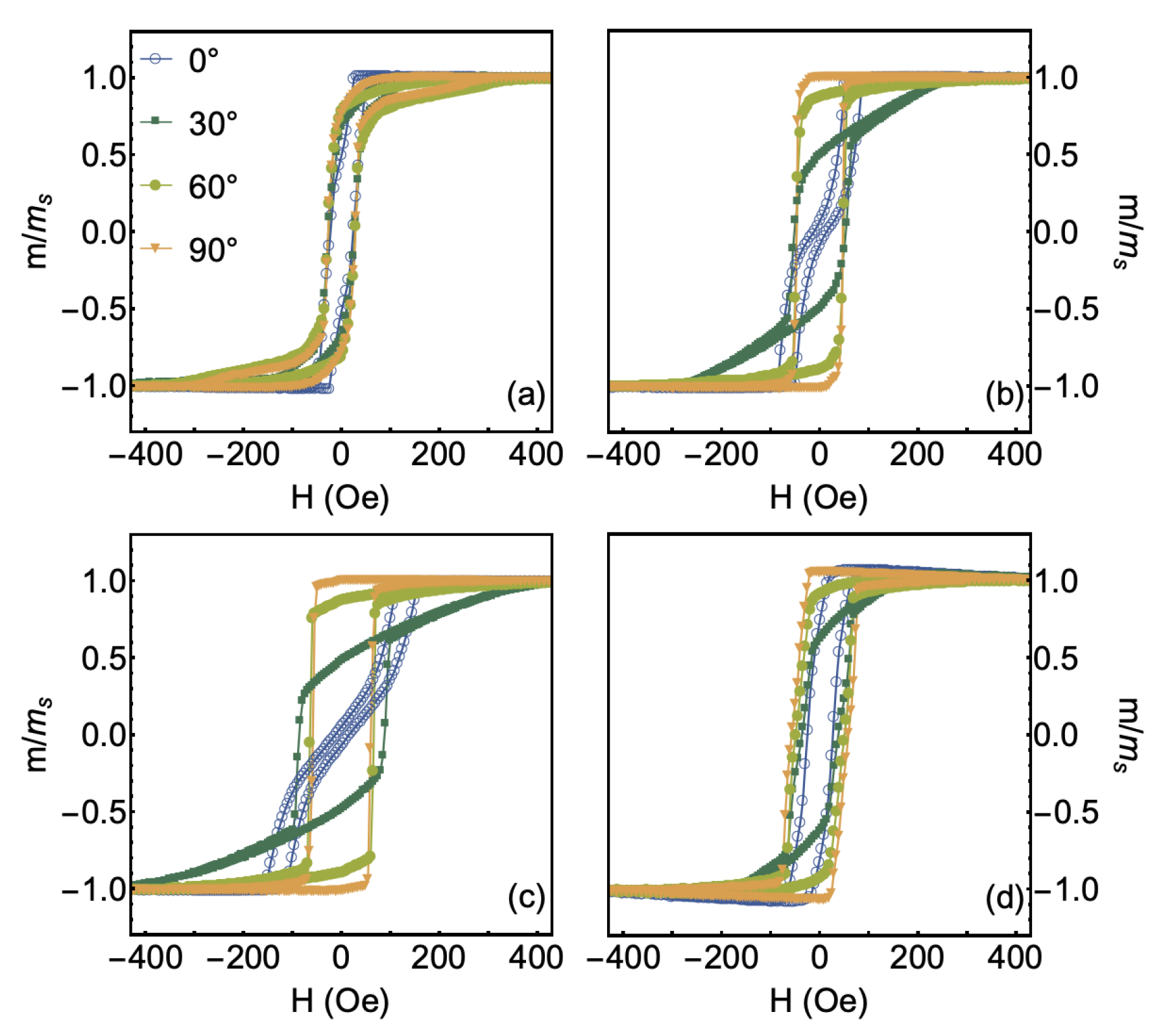
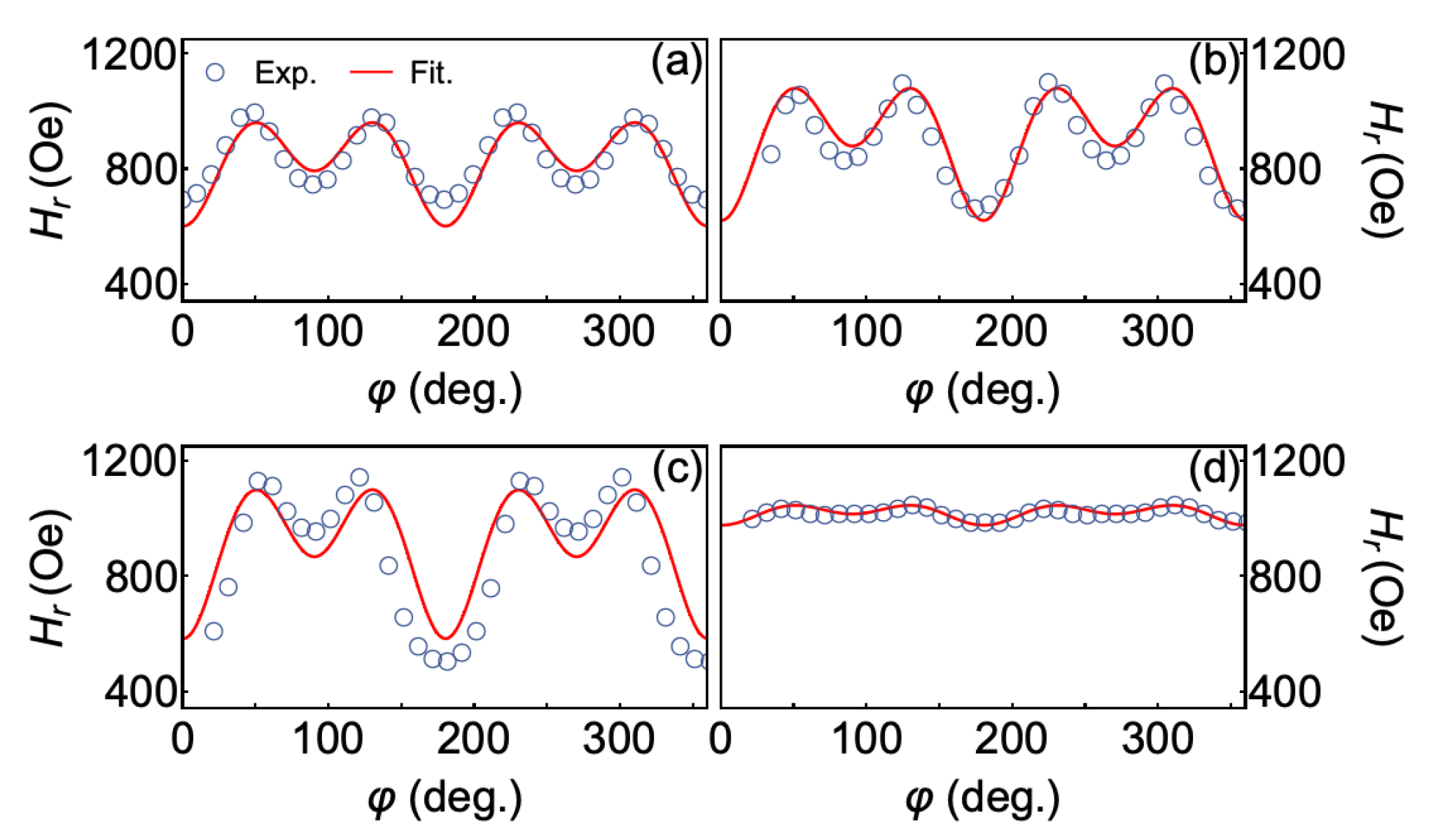
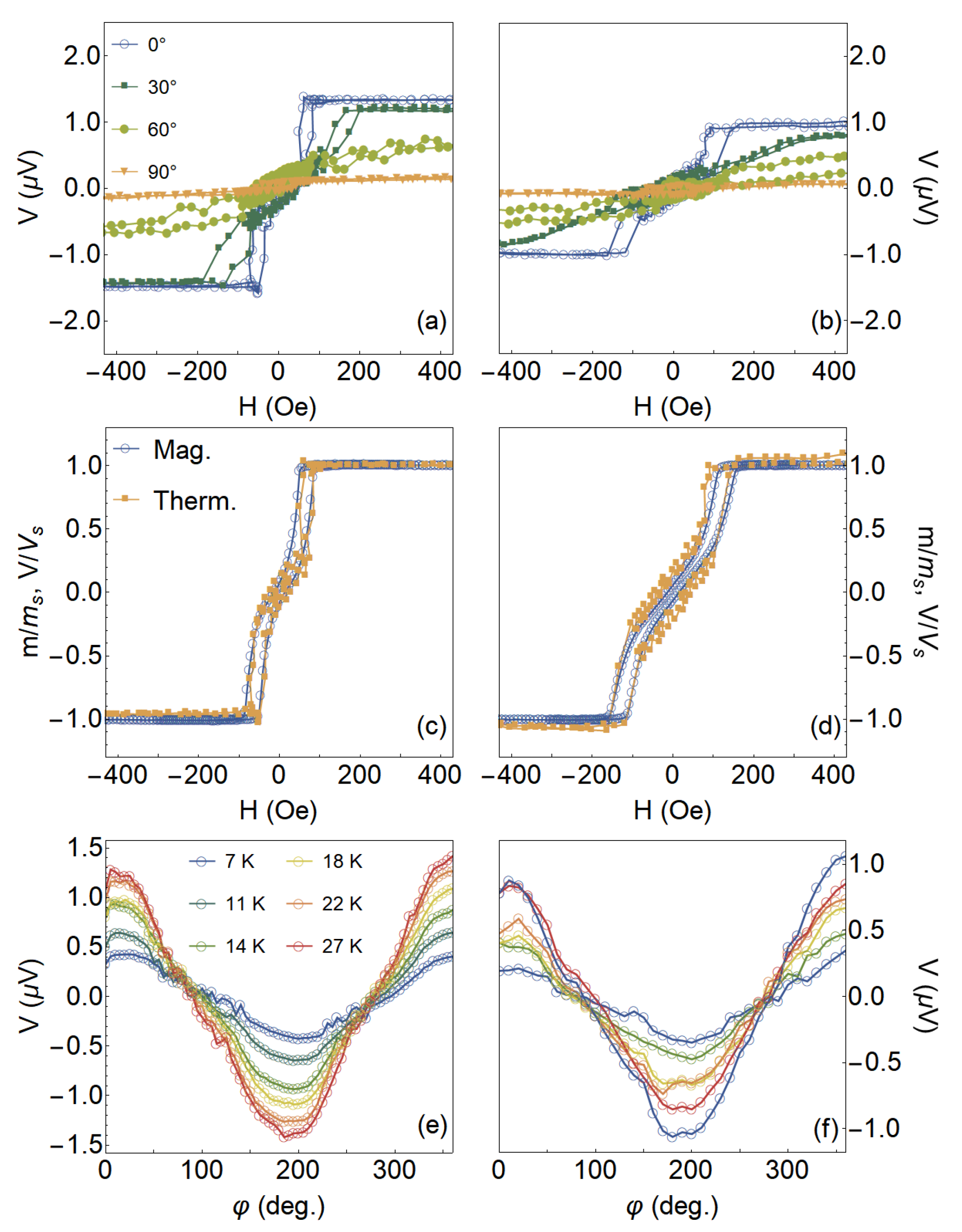

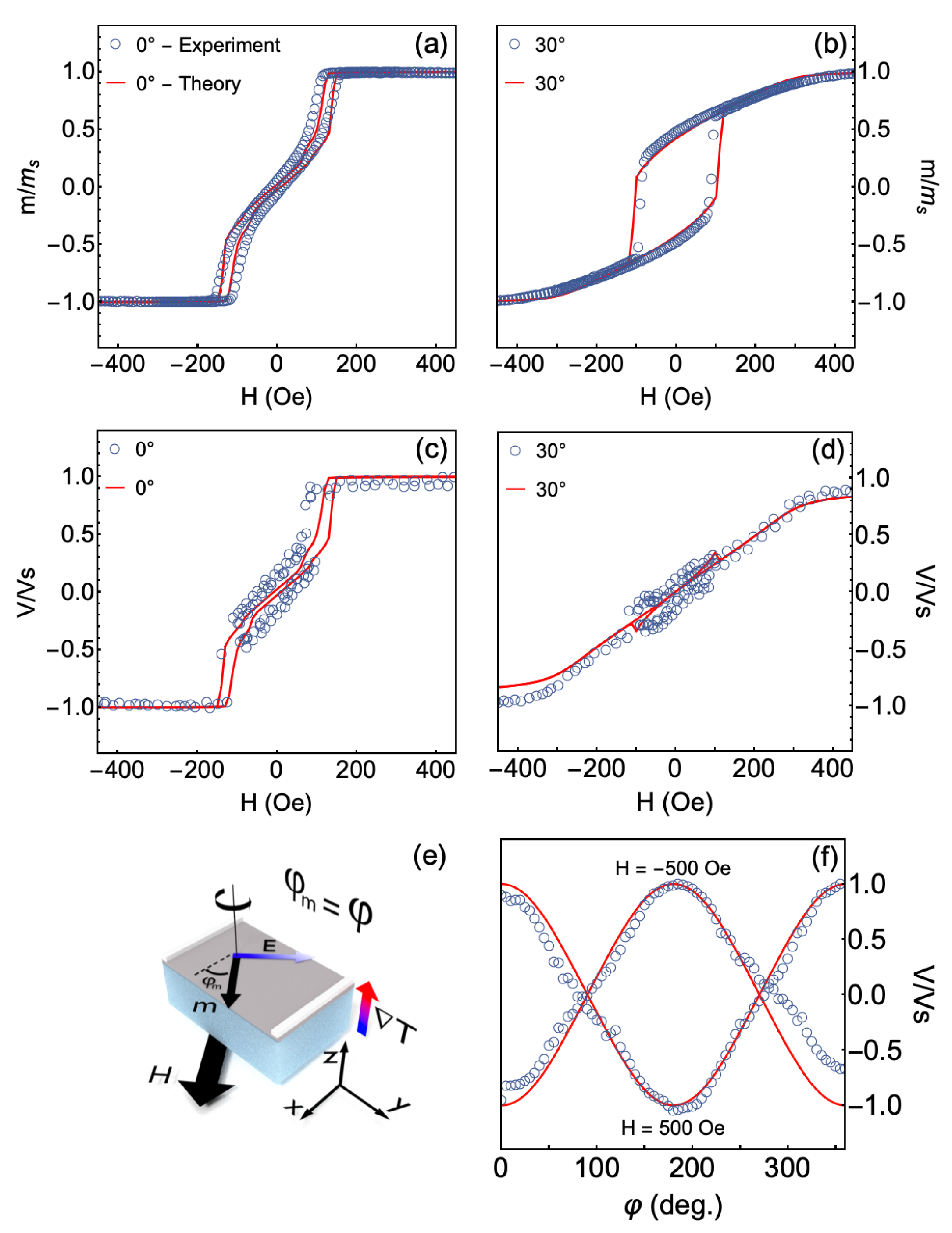
| CFA Grown Temperature (K) | (emu/cm) | (ergs/cm) | (ergs/cm) |
|---|---|---|---|
| 300 | 1340 | ||
| 573 | 1330 | ||
| 673 | 1330 | ||
| 773 | 1328 |
© 2020 by the authors. Licensee MDPI, Basel, Switzerland. This article is an open access article distributed under the terms and conditions of the Creative Commons Attribution (CC BY) license (http://creativecommons.org/licenses/by/4.0/).
Share and Cite
Lopes, M.V.; de Souza, E.C.; Santos, J.G.; de Araujo, J.M.; Lima, L.; de Oliveira, A.B.; Bohn, F.; Correa, M.A. Modulating the Spin Seebeck Effect in Co2FeAl Heusler Alloy for Sensor Applications. Sensors 2020, 20, 1387. https://doi.org/10.3390/s20051387
Lopes MV, de Souza EC, Santos JG, de Araujo JM, Lima L, de Oliveira AB, Bohn F, Correa MA. Modulating the Spin Seebeck Effect in Co2FeAl Heusler Alloy for Sensor Applications. Sensors. 2020; 20(5):1387. https://doi.org/10.3390/s20051387
Chicago/Turabian StyleLopes, Marcus Vinicius, Edycleyson Carlos de Souza, João Gustavo Santos, João Medeiros de Araujo, Lessandro Lima, Alexandre Barbosa de Oliveira, Felipe Bohn, and Marcio Assolin Correa. 2020. "Modulating the Spin Seebeck Effect in Co2FeAl Heusler Alloy for Sensor Applications" Sensors 20, no. 5: 1387. https://doi.org/10.3390/s20051387
APA StyleLopes, M. V., de Souza, E. C., Santos, J. G., de Araujo, J. M., Lima, L., de Oliveira, A. B., Bohn, F., & Correa, M. A. (2020). Modulating the Spin Seebeck Effect in Co2FeAl Heusler Alloy for Sensor Applications. Sensors, 20(5), 1387. https://doi.org/10.3390/s20051387






